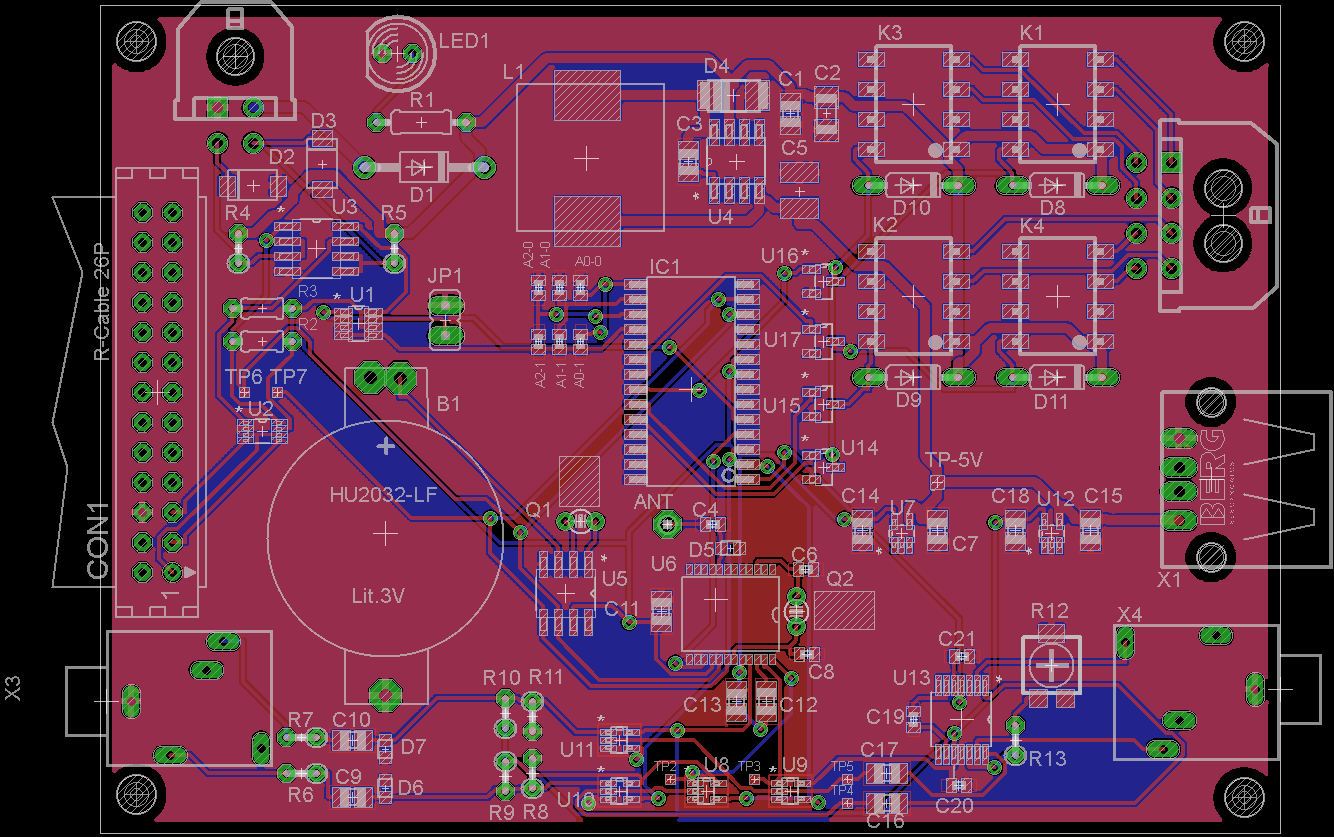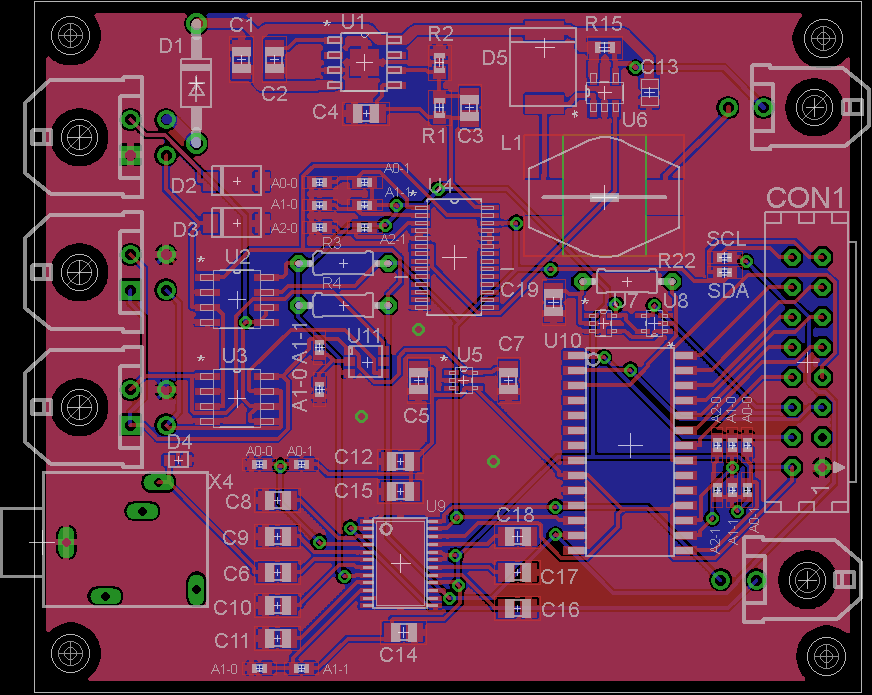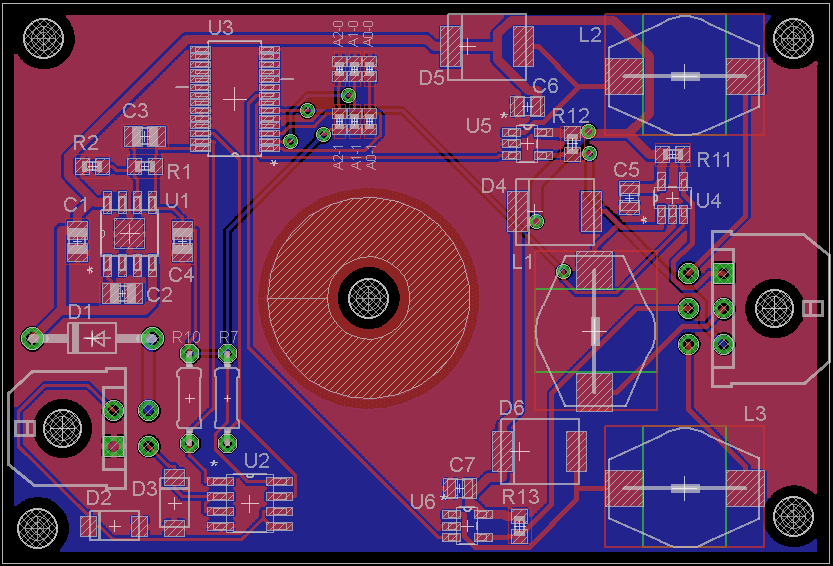Still one displayboard and leddriver board to assemble...
Wednesday, December 18, 2013
Tuesday, December 17, 2013
Getting crowdy on the bus....
Assembling the second display board. These are all the i2c adresses at this moment. 4 adresses will be added when all boards are fully assembled.
[root@rgbclock ~]# i2cdetect -y 1
0 1 2 3 4 5 6 7 8 9 a b c d e f
00: -- -- -- -- -- -- -- -- -- -- -- -- --
10: -- -- -- -- -- -- -- -- -- -- -- -- -- -- -- --
20: 20 21 22 -- -- -- -- -- -- 29 -- -- -- -- -- --
30: -- -- -- -- -- -- -- -- -- -- -- -- -- -- -- --
40: 40 41 -- -- -- -- -- -- -- -- -- -- -- -- -- --
50: -- -- -- -- -- -- -- -- -- -- 5a -- -- -- -- --
60: -- -- -- 63 -- -- -- -- 68 -- -- -- 6c -- -- --
70: 70 -- -- -- -- -- -- --
Monday, November 11, 2013
Panelizing the 3 boards
I have combined all 3 boards into a single board (panalizing, reducing board costs) using this tutorial:
http://www.instructables.com/id/Panelizing-PCBs-for-Seeed-Using-Eagle-Free-Light/
Gerbmerge:
http://ruggedcircuits.com/gerbmerge/
http://www.instructables.com/id/Panelizing-PCBs-for-Seeed-Using-Eagle-Free-Light/
Gerbmerge:
http://ruggedcircuits.com/gerbmerge/
3 boards routed !
I managed to route all 3 boards ! Still some minor changes needed to the mainboard.
Special thanks to http://www.freerouting.net/ for doing the autorouting part. All routes where routed with this autorouter. Only a few routes where manually routed (especially around the FM receiver).
Mainboard:
Displayboard:
Leddriverboard:
Special thanks to http://www.freerouting.net/ for doing the autorouting part. All routes where routed with this autorouter. Only a few routes where manually routed (especially around the FM receiver).
Mainboard:
Friday, November 1, 2013
First draft of Mainboard, Displayboard and Leddriver board
Wednesday, October 23, 2013
First version of mainboard schematic
A first (draft) version of the mainboard schematic is available here:
https://rgb-clock.googlecode.com/svn/trunk/pcb/RGBClock/Mainboard.pdf
https://rgb-clock.googlecode.com/svn/trunk/pcb/RGBClock/Mainboard.pdf
Wednesday, October 9, 2013
Eagle library parts
I'm surprised to learn that creating Eagle library parts is actually quite easy; see this tutorial:
http://www.msilverman.me/2010/06/creating-a-new-device-in-eagle/
And it is even faster when you copy a existing symbol/package. In my case the library for the Si4735-D50 FM receiver...
http://www.msilverman.me/2010/06/creating-a-new-device-in-eagle/
And it is even faster when you copy a existing symbol/package. In my case the library for the Si4735-D50 FM receiver...
Monday, October 7, 2013
Schematics of PWM LED driver prototype board (PCA9685 and ZXLD1362 as main components)
I have uploaded the schematics of the PWM driver prototype board. It was just a test board to get started with Eagle software.
You can view the schema here. I'll start the schema entry of the other boards in the next days; all files will be available on the source page.
You can view the schema here. I'll start the schema entry of the other boards in the next days; all files will be available on the source page.
Thursday, September 5, 2013
Software development
Continuing the software development of my alarm clock. I have added the automatic detection of units (display units, light units) via the I2C bus. I will start with the alarm function (main feature :-))
When this is complete, i'll start redesigning the new PCB's:
- Main unit (FM Radio, RTC clock, I2C and Audio buffers)
- Display units (Display, Amplifier, Touch button sensor, Licht sensor,...)
- Light Units (PWM control, LED driver)
When this is complete, i'll start redesigning the new PCB's:
- Main unit (FM Radio, RTC clock, I2C and Audio buffers)
- Display units (Display, Amplifier, Touch button sensor, Licht sensor,...)
- Light Units (PWM control, LED driver)
Thursday, June 27, 2013
Wednesday, June 26, 2013
Started writing the actual software
Alpha version of the hardware has been a little bit cleaned-up.
Started to write the real software. All previous software was just about testing hardware. I'm now writing the application as I want the application, re-using the previous test classes.
Looking nice ! Keyboard is working; i'm able to make the difference between short and long keypresses. Accuracy of the MPR121 is actually (after some tweaking) very good.
Connected the light to the keyboard events; i'm now able to control the (RGB) Leds; PWM dimming !
Radio (FMReceiver and Amplifier) is also connected to these keyboard events. Coded some shortcuts, but i'm able to control the volume of the amplifier.
Next:
Started to write the real software. All previous software was just about testing hardware. I'm now writing the application as I want the application, re-using the previous test classes.
Looking nice ! Keyboard is working; i'm able to make the difference between short and long keypresses. Accuracy of the MPR121 is actually (after some tweaking) very good.
Connected the light to the keyboard events; i'm now able to control the (RGB) Leds; PWM dimming !
Radio (FMReceiver and Amplifier) is also connected to these keyboard events. Coded some shortcuts, but i'm able to control the volume of the amplifier.
Next:
- Add more features to the Light: slow startup of the light intensity (wakeup with light). Manual power on and off; make it less abrupt (need some sort of fast dimm off, dimm on.
- Clean-up the radio & amplifier code
- Connecting the display classes ...
- Actual writing the alarm settings & processing....
- ....
Thursday, June 20, 2013
- Raspberry Pi
- RGB PWD control (PCA9685 + ZXLD1362)
- I2C bus extender (P82B96)
- Radio circuit (Si4730)
- Audio line buffer (DRV612)
- Amplifier (TPA0172)
- LCD Display (Newhaven Display NHD-16032AZ + MCP23017)
- Light sensor (TSL2561)
- Touch button sensor (MPR121)
- Create all PCB's
- Actually writing the software
- Testing... lots of testing....
- Add an extra IO Expander (driving relay's)
Subscribe to:
Comments (Atom)





